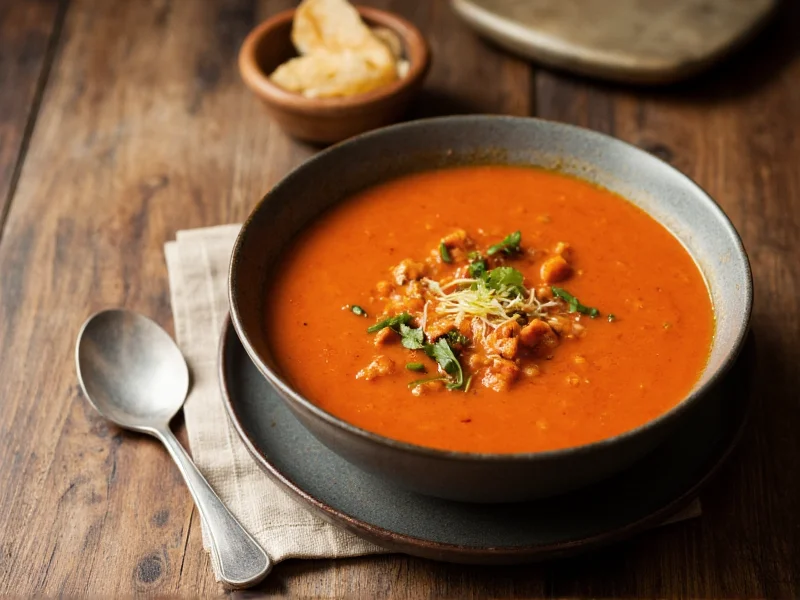The Historical Evolution of Soup Dishes
Soup preparation dates back to prehistoric times when early humans discovered boiling food in water created more digestible meals. Archaeological evidence shows ancient civilizations across China, Greece, and Rome all developed unique soup traditions. The word “soup” itself derives from the French “soupe,” originally referring to bread soaked in broth—a practice so culturally significant that medieval French law required bakers to provide soup bread.
During the 17th century, French chef Nicolas de Bonnefons documented early techniques for clear broths, while the 19th century saw Auguste Escoffier formalize French soup classifications that still influence culinary education today. Industrialization brought canned soups to mass markets, though traditional slow-simmered preparations remain valued for superior flavor development.
Global Soup Classifications and Varieties
Chefs categorize soups using several frameworks based on ingredients, preparation methods, and cultural origins. The following table outlines major classifications:
| Soup Category | Key Characteristics | Signature Examples |
|---|---|---|
| Bouillon/Fond | Clear, strained broth from simmered bones | Consommé, Pho broth, Miso dashi |
| Cream Soups | Thickened with dairy, purees, or roux | Bisque, Vichyssoise, Cream of mushroom |
| Puree Soups | Blended vegetables or legumes without dairy | French onion, Lentil, Pumpkin |
| Chowders | Chunky seafood or vegetable preparations | New England clam, Corn, Manhattan fish |
| International Specialties | Culturally distinct preparations | Miso (Japan), Borscht (Eastern Europe), Caldo (Latin America) |
Nutritional Benefits and Health Considerations
Well-prepared soups offer significant nutritional advantages when made with whole ingredients. Vegetable-based soups provide concentrated vitamins and minerals while maintaining hydration. Bone broths contain collagen and amino acids that support joint health. The slow simmering process breaks down nutrients into more bioavailable forms compared to raw consumption.
Research published in the Journal of the Academy of Nutrition and Dietetics indicates regular soup consumption correlates with lower body weight and improved nutrient intake. However, commercial canned varieties often contain excessive sodium—typically 800-1000mg per serving—while homemade versions allow precise sodium control. For optimal health benefits, nutritionists recommend soups featuring diverse vegetables, lean proteins, and minimal added fats.
Essential Soup-Making Techniques
Mastering fundamental soup preparation methods ensures consistent results regardless of recipe complexity. Professional chefs emphasize these critical techniques:
- Proper stock preparation: Simmer bones and aromatics for 4-12 hours to extract maximum flavor and collagen
- Mise en place organization: Prepare all ingredients before starting to maintain consistent cooking times
- Layered flavor development: Sauté aromatics before adding liquid to create deeper flavor profiles
- Temperature control: Maintain gentle simmer rather than rolling boil to prevent ingredient breakdown
- Seasoning progression: Adjust salt and acid gradually throughout cooking process
For clear broths, the clarification process using egg whites and ground meat (for consommé) demonstrates advanced technique that removes impurities while concentrating flavors. Pureed soups achieve optimal texture through careful blending while hot liquids require special safety precautions.
Cultural Significance Across Regions
Soup traditions reflect cultural identities worldwide. In France, potage remains a formal course in traditional meal structure, while Japanese miso soup accompanies nearly every breakfast. Eastern European borscht carries historical significance as both peasant food and celebratory dish. Latin American caldos often serve medicinal purposes during illness.
Anthropological studies reveal soup’s role in community building—the communal pot symbolizes sharing and hospitality across diverse cultures. Many traditional societies reserve specific soups for seasonal celebrations or rites of passage, demonstrating how these liquid dishes transcend mere sustenance to embody cultural values and social connections.
Modern Innovations in Soup Preparation
Contemporary chefs continue evolving soup traditions through innovative techniques and ingredient combinations. Molecular gastronomy has introduced spherified broths and edible soup containers. Pressure cookers and immersion circulators enable precise temperature control previously unattainable in home kitchens.
Sustainability concerns drive renewed interest in “root-to-stem” soup preparation, minimizing food waste by utilizing vegetable peels, meat bones, and herb stems. Global flavor fusion creates exciting hybrids like kimchi ramen broth or jerk-spiced pumpkin soup, reflecting increasingly interconnected culinary landscapes while maintaining soup’s fundamental comforting qualities.
What distinguishes French soups from other culinary traditions?
French soup traditions emphasize clear broths (bouillons) and precise thickening methods. Classic French technique separates soups into categories like potage (thick vegetable soups), consommé (clarified broths), and bisque (creamy shellfish preparations). French culinary schools teach soup-making as foundational skill, with emphasis on slow-simmered stocks and balanced seasoning—principles that have influenced professional kitchens worldwide.
How can home cooks improve the flavor of homemade soups?
Professional chefs recommend several flavor-enhancing techniques: first, sauté aromatics like onions, carrots, and celery before adding liquid to develop deeper flavors through caramelization. Second, incorporate umami-rich ingredients such as tomato paste, mushrooms, or Parmesan rinds. Third, finish with acid (lemon juice or vinegar) to brighten flavors. Finally, allow soups to rest overnight—this resting period lets flavors fully integrate and often improves taste significantly.
What’s the difference between soup and stew?
The primary distinction lies in liquid content and preparation method. Soups contain more broth relative to solid ingredients and typically feature smaller, uniformly cut components that cook relatively quickly. Stews have less liquid, with larger ingredient pieces that require longer braising to become tender. While soups often serve as first courses, stews function as complete main dishes. The texture difference is notable—soups remain pourable, while stews maintain a spoon-standing consistency.
Which vegetables work best for nutrient-dense vegetable soups?
For maximum nutritional value, combine vegetables with complementary nutrient profiles. Dark leafy greens (kale, spinach) provide iron and vitamins A/C/K. Orange vegetables (carrots, sweet potatoes) offer beta-carotene. Cruciferous vegetables (broccoli, cauliflower) contribute sulforaphane. Alliums (onions, garlic) contain beneficial organosulfur compounds. To preserve nutrients, add delicate greens near the end of cooking while heartier vegetables like root crops should simmer longer. Including a small amount of healthy fat (olive oil) enhances absorption of fat-soluble vitamins.











 浙公网安备
33010002000092号
浙公网安备
33010002000092号 浙B2-20120091-4
浙B2-20120091-4